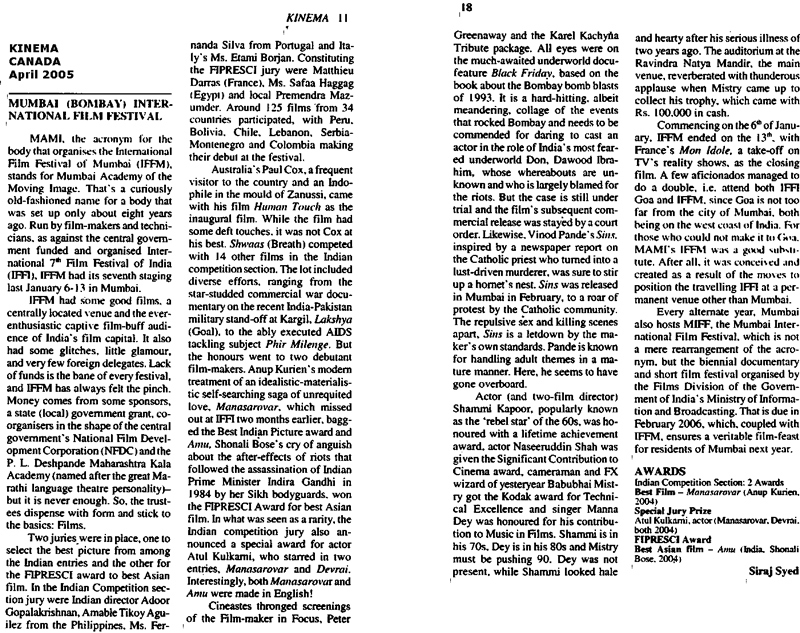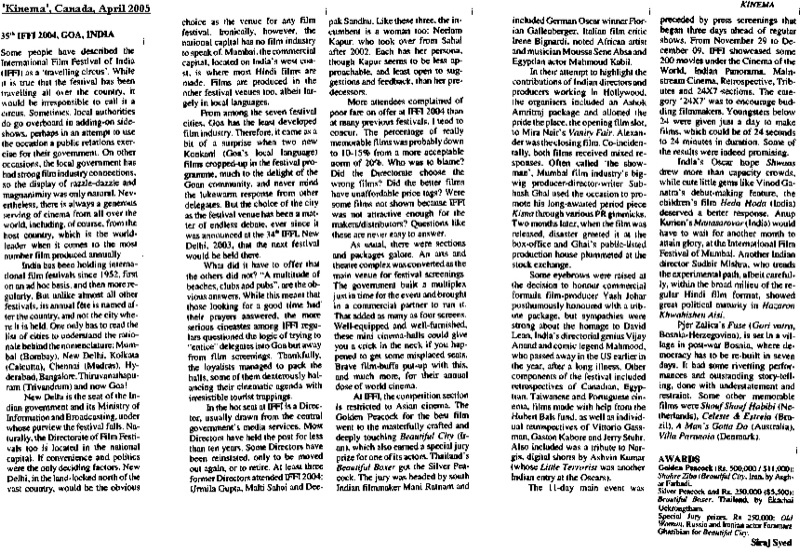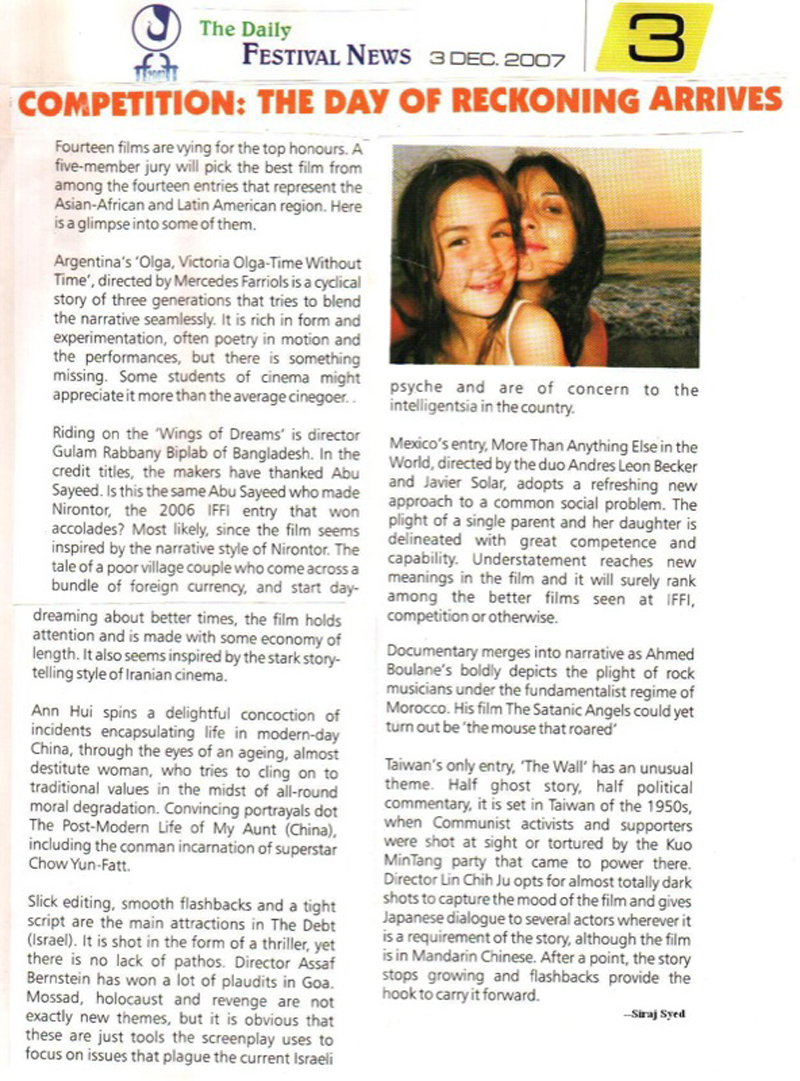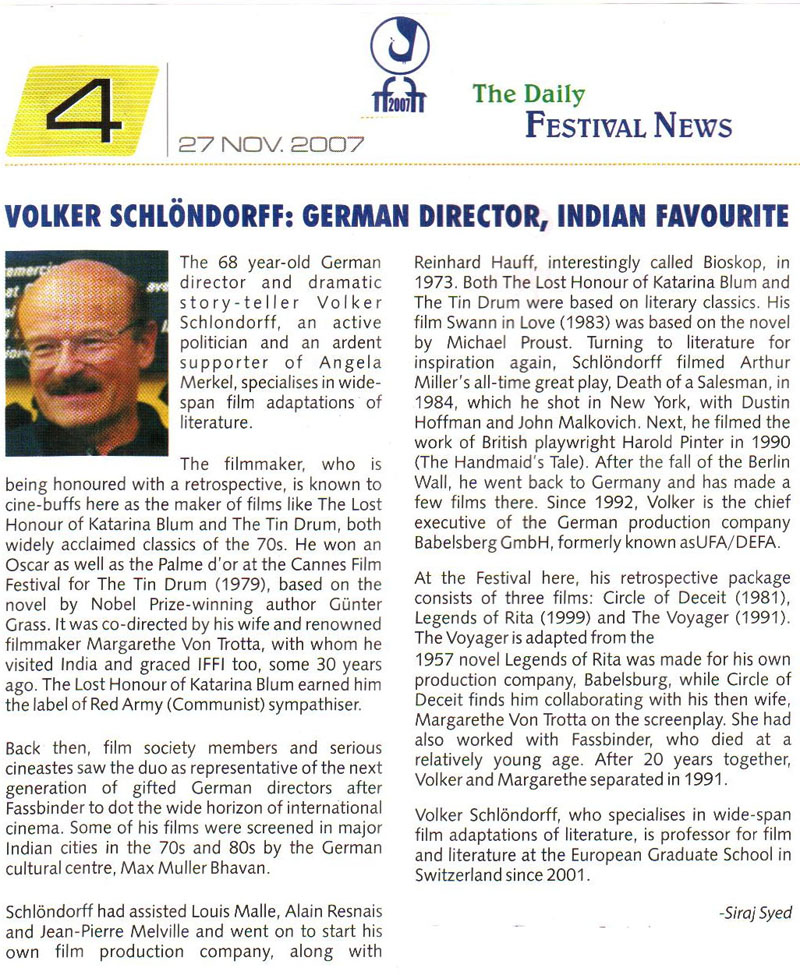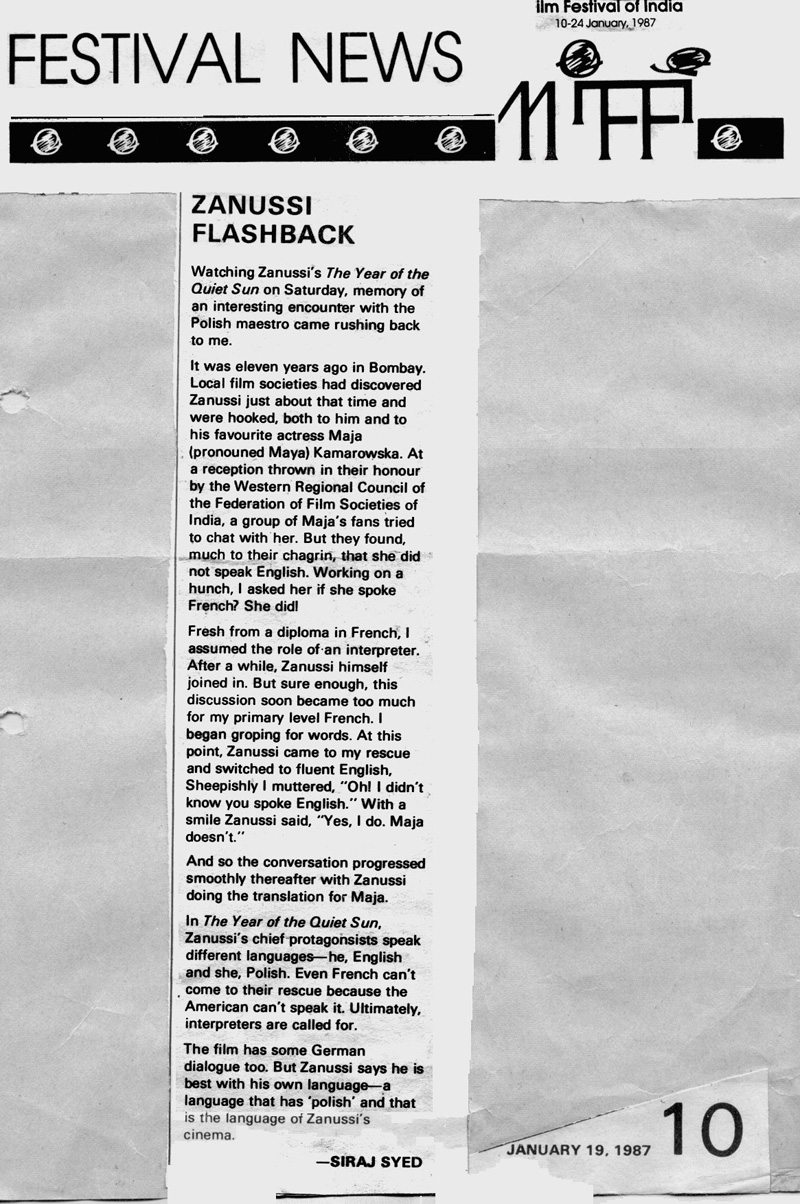|
|
||
|
Pro Tools
FILMFESTIVALS | 24/7 world wide coverageWelcome ! Enjoy the best of both worlds: Film & Festival News, exploring the best of the film festivals community. Launched in 1995, relentlessly connecting films to festivals, documenting and promoting festivals worldwide. Sorry for the disruptions we are working on the platform as of today. For collaboration, editorial contributions, or publicity, please send us an email here. User loginActive Members |
Siraj SyedSiraj Syed is the India Correspondent for FilmFestivals.com and a member of FIPRESCI, the International Federation of Film Critics. He is a Film Festival Correspondent since 1976, Film-critic since 1969 and a Feature-writer since 1970. He is also an acting and dialogue coach. @SirajHSyed  Chehere: A Modern Day Classic, Review: What’s in a name?
Chehere: A Modern Day Classic, Review: What’s in a name? Even seven years after it was shot, Chehere: A Modern Day Classic, was unlikely to see even the light of modern day. That it has managed to reach the screen is a miracle, as is the survival of its lead actress, Manisha Koirala, who was battling cancer when the film was almost complete. First screened at the Pravasi Film Festival, New Delhi, in 2010, probably short of a few Manisha scenes, the film was initially titled Badalte Chehere. Described in many media vehicles as the directorial debut of Rohit Kaushik, it is, in fact, his second feature, the first being Mera Dil Leke Dekho (2006), produced by actor Shatrughan and his former actress wife Poonam Sinha, under their Shotgun Films banner, with their daughter and present-day star Sonakshi Sinha as the Costumer. Few critics reviewed the film, and those who did were rather unkind. Kaushik is listed on the website of Monalysa Productions as the maker of over 250 ad films. Mera Dil Leke Dekho did not add to his credentials. Chehere might be a marginal improvement, at best. Set in England, circa 1952, the story is largely about an old-time Indian actress of the late 1920s and early 1930s, Tarana (Manisha Koirala) and her wheel-chair bound sister (a recent car accident), Amaanat (Divya Dutta), who have moved to British countryside home, after Tarana’s career took a nose-dive. Unable to sing or dance well, Tarana, a good actress when it came to emoting, could not cope with the advent of talkies and singing stars. Even her benefactor, playboy producer RaiSaahab (Jackie Shroff) agreed to a replacement, in tune with the times. She now lives a life caught in a time warp, singing and dancing to her sister’s songs, preening, melancholic, nostalgic and resigned to her fate. Some 20 years after quitting films, Tarana throws a birthday party at her mansion, with a select group of invitees attending. They include RaiSaahab and his wife (Hrishita Bhatt), an actress who used to be a chorus dancer while Tarana was the star, Dr. Nigam (Gulshan Grover), a man madly in love with Tarana, who migrated to England just so that he could be around his beloved, Tarana’s ‘adopted daughter’ (Geeta Vig) and her boy-friend (Aarya Babbar), a forensic expert specialising in poisons. There are four Indian servants in the house and a British butler. The retinue includes one who is like a family-member (Bob Brahmabhatt) and another who is a garrulous bumpkin (Rakesh Bedi), and they all keep squabbling. So, when Amaanat is found dead in her bed, there are at least ten suspects. What makes it really murky is the real-life case of the Sheena Bora murder that surfaced only last week but has uncanny similarities to the Kaushik script, written at least seven years ago! Anyway, so there is a murder, a body and suspects with motives. Whodunit? Taking credit for the story and screenplay too, Rohit Kaushik (not to be confused with writer-composer or stage artiste Rohit Kaushik) is the prime suspect himself, and he must take almost all the blame for concocting a confused and convoluted murder mystery. During the intermission at the press preview, he told this writer that he was a great fan of Agatha Christie and P.D. James, had spent some quality time with Glenda Jackson, Katharine Hepburn and John Malkovich, and that the second half of the film we were watching would reach dizzy heights of emotions and suspense. Agatha Christie’s influence is all over, only there is no Miss Marple or Hercule Poirot around, and neither is plot a patch on Dame Christie’s narrative technique. What’s more, in a first of sorts, the guilty do not need much prodding to confess. Like in all murder mysteries, more than one suspect had motives and opportunities to perform the dastardly act—it could be one or more of them. What Kaushik imbibed from the three veteran actors he named remains to be established. And the second half of the film turned out to be a steep climb-down, not an ascending graph. Kaushik gives his narrative a good start, and brisk pace. After that, the film gets lost amidst jerky entries of the cast, shouting and bickering matches and over-acting. Well-conceived black and white flash-backs, some sensual poses, painting-like imagery, delicate lighting, carefully chosen Urdu couplets, and mood-based tuneful music cannot throw the drowning film a straw to cling on to. Dialogue by Mahendra Pratap Singh shows good command over Hindi and Urdu, the latter being essential in creating the ambience of the era, except when some classic lines are fractured in delivery. Having sold the one-pager as a story idea, Kaushik is unable to develop it into a cohesive screenplay. Time-lines are muddled; the source of Tarana’s immense wealth lasting decades after her bidding adieu to the profession never explained; the pretentious redundancy of the forensic expert at the scene of the crime sticks out like sore thumb; Dr. Nigam’s nervousness is unconvincingly explained as his need for drink; no logic is put forward for the detaining all the guests in the mansion till the investigation is complete; Tarana says that their mother used to sing a lullaby to her and to Amaanat, but the song she hums is from a film released in 1952, when their mother would have been dead for many years—there are discordant notes galore. Reposing faith in the director of their failed first pairing (Kaushik said Shroff has stood strongly by him), Jackie Shroff acts above his wont, and even mouths some shairi (Urdu poetry) without sounding funny. Manisha Koirala shares screen space with Jackie for the umpteenth time and acts her part well. Gulshan Grover is always dependable. Divya Dutta has said that her character was modelled after tragedienne actress, late Meena Kumari, of whom she is a great fan. Incidentally, many scenes of the film were shot at Kamalistan, the studio owned by Meena’s producer-director husband, late Kamaal Amrohi. Dutta is full of joie de vivre and self-pity, as a deadly mix. Hrishita Bhatt (Asoka, Dil Vil Pyar Vyar, Miss Tanakpur Haazir Ho) shows she is capable of much more than those item song appearances. Aarya Babbar (Guru, Tees Maar Khan, Bangistan), son of actors Raj and Nadira Babbar, is made to ape Dev Anand and speak softly, with his face upturned, in a wasted outing. Seen earlier in Marigold, Geeta Vig fails to impress, while comedian Rakesh Bedi is made to speak pointless lines and perform meaningless acts. Bob Brahmbhatt (Janasheen, Gumnaam: The Mystery, Kites), Executive Producer of the film and brother of singer Bali Brahmbhatt, gets a meaty, low-profile role, which he delivers fairly. Almost all actors suffer from ill-defined parts, hiding their true faces, broadly personified, but devoid of micro delineation. Inspired songs are written by Sayeed Quadri and composed by Jaideep Chowdhury, while the background score composer, Sanjoy Chowdhury, is the son of the legendary music director, late Salil Chowdhury. Due credit to Thomas Xavier (cinematography), Bijon Dasgupta (art), Rekha Chinni Prakash (choreography), Soniya Dhingra and Umang Mehta (costumes) and Jitendra Chaudhary (sound design). For the close-cut introductory sequences, kudos to the unbilled editor. Pity all these contributions are towards a lost cause. Chehere (oddly spelt, meaning 'faces'): A Modern Day Classic is an overly ambitious and self-congratulatory title for a film. But then, you can call your film what you like! What’s in a name? Rating: *1/2 Trailer: https://www.youtube.com/watch?v=kleasVyyfrM 28.08.2015 | Siraj Syed's blog Cat. : Aarya Babbar Agatha Christie Bob Brahmbhatt Divya Dutta Geeta Vig Glenda Jackson Gulshan Grover Hrishita Bhatt Jackie Shroff Jon Malkovich Katharine Hepburn Mahendra Pratap Singh Manisha Koirala mansion murder Nadira P.D. James poison Poonam Sinha Raj Babbar Rakesh Bedi Rekha Chinni Prakash Rohit Kaushik Sanjoy Chowdhury Sayeed Quadri shairi Shatrughan Sinha silent films Sonakshi Sinha talkies Urdu whodunit Independent
|
LinksThe Bulletin Board > The Bulletin Board Blog Following News Interview with EFM (Berlin) Director
Interview with IFTA Chairman (AFM)
Interview with Cannes Marche du Film Director
Filmfestivals.com dailies live coverage from > Live from India
Useful links for the indies: > Big files transfer
+ SUBSCRIBE to the weekly Newsletter DealsUser imagesAbout Siraj Syed Syed Siraj Syed Siraj (Siraj Associates) Siraj Syed is a film-critic since 1970 and a Former President of the Freelance Film Journalists' Combine of India.He is the India Correspondent of FilmFestivals.com and a member of FIPRESCI, the international Federation of Film Critics, Munich, GermanySiraj Syed has contributed over 1,015 articles on cinema, international film festivals, conventions, exhibitions, etc., most recently, at IFFI (Goa), MIFF (Mumbai), MFF/MAMI (Mumbai) and CommunicAsia (Singapore). He often edits film festival daily bulletins.He is also an actor and a dubbing artiste. Further, he has been teaching media, acting and dubbing at over 30 institutes in India and Singapore, since 1984.View my profile Send me a message The Editor |




